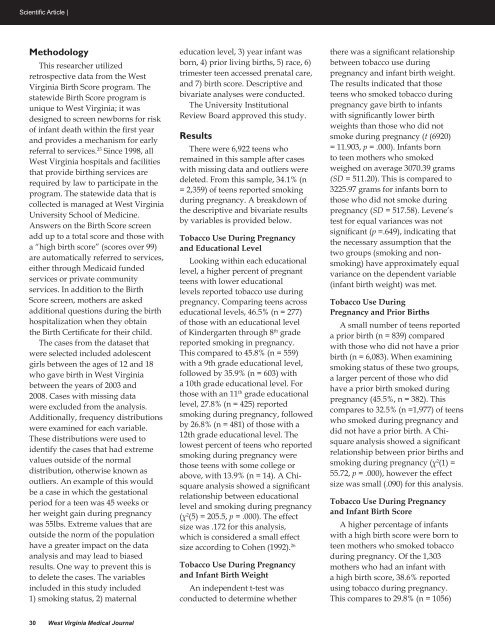Adam E. Klein, MD - West Virginia State Medical Association
Adam E. Klein, MD - West Virginia State Medical Association
Adam E. Klein, MD - West Virginia State Medical Association
You also want an ePaper? Increase the reach of your titles
YUMPU automatically turns print PDFs into web optimized ePapers that Google loves.
Scientific Article |MethodologyThis researcher utilizedretrospective data from the <strong>West</strong><strong>Virginia</strong> Birth Score program. Thestatewide Birth Score program isunique to <strong>West</strong> <strong>Virginia</strong>; it wasdesigned to screen newborns for riskof infant death within the first yearand provides a mechanism for earlyreferral to services. 25 Since 1998, all<strong>West</strong> <strong>Virginia</strong> hospitals and facilitiesthat provide birthing services arerequired by law to participate in theprogram. The statewide data that iscollected is managed at <strong>West</strong> <strong>Virginia</strong>University School of Medicine.Answers on the Birth Score screenadd up to a total score and those witha “high birth score” (scores over 99)are automatically referred to services,either through Medicaid fundedservices or private communityservices. In addition to the BirthScore screen, mothers are askedadditional questions during the birthhospitalization when they obtainthe Birth Certificate for their child.The cases from the dataset thatwere selected included adolescentgirls between the ages of 12 and 18who gave birth in <strong>West</strong> <strong>Virginia</strong>between the years of 2003 and2008. Cases with missing datawere excluded from the analysis.Additionally, frequency distributionswere examined for each variable.These distributions were used toidentify the cases that had extremevalues outside of the normaldistribution, otherwise known asoutliers. An example of this wouldbe a case in which the gestationalperiod for a teen was 45 weeks orher weight gain during pregnancywas 55lbs. Extreme values that areoutside the norm of the populationhave a greater impact on the dataanalysis and may lead to biasedresults. One way to prevent this isto delete the cases. The variablesincluded in this study included1) smoking status, 2) maternaleducation level, 3) year infant wasborn, 4) prior living births, 5) race, 6)trimester teen accessed prenatal care,and 7) birth score. Descriptive andbivariate analyses were conducted.The University InstitutionalReview Board approved this study.ResultsThere were 6,922 teens whoremained in this sample after caseswith missing data and outliers weredeleted. From this sample, 34.1% (n= 2,359) of teens reported smokingduring pregnancy. A breakdown ofthe descriptive and bivariate resultsby variables is provided below.Tobacco Use During Pregnancyand Educational LevelLooking within each educationallevel, a higher percent of pregnantteens with lower educationallevels reported tobacco use duringpregnancy. Comparing teens acrosseducational levels, 46.5% (n = 277)of those with an educational levelof Kindergarten through 8 th gradereported smoking in pregnancy.This compared to 45.8% (n = 559)with a 9th grade educational level,followed by 35.9% (n = 603) witha 10th grade educational level. Forthose with an 11 th grade educationallevel, 27.8% (n = 425) reportedsmoking during pregnancy, followedby 26.8% (n = 481) of those with a12th grade educational level. Thelowest percent of teens who reportedsmoking during pregnancy werethose teens with some college orabove, with 13.9% (n = 14). A Chisquareanalysis showed a significantrelationship between educationallevel and smoking during pregnancy(χ 2 (5) = 205.5, p = .000). The effectsize was .172 for this analysis,which is considered a small effectsize according to Cohen (1992). 26Tobacco Use During Pregnancyand Infant Birth WeightAn independent t-test wasconducted to determine whetherthere was a significant relationshipbetween tobacco use duringpregnancy and infant birth weight.The results indicated that thoseteens who smoked tobacco duringpregnancy gave birth to infantswith significantly lower birthweights than those who did notsmoke during pregnancy (t (6920)= 11.903, p = .000). Infants bornto teen mothers who smokedweighed on average 3070.39 grams(SD = 511.20). This is compared to3225.97 grams for infants born tothose who did not smoke duringpregnancy (SD = 517.58). Levene’stest for equal variances was notsignificant (p =.649), indicating thatthe necessary assumption that thetwo groups (smoking and nonsmoking)have approximately equalvariance on the dependent variable(infant birth weight) was met.Tobacco Use DuringPregnancy and Prior BirthsA small number of teens reporteda prior birth (n = 839) comparedwith those who did not have a priorbirth (n = 6,083). When examiningsmoking status of these two groups,a larger percent of those who didhave a prior birth smoked duringpregnancy (45.5%, n = 382). Thiscompares to 32.5% (n =1,977) of teenswho smoked during pregnancy anddid not have a prior birth. A Chisquareanalysis showed a significantrelationship between prior births andsmoking during pregnancy (χ 2 (1) =55.72, p = .000), however the effectsize was small (.090) for this analysis.Tobacco Use During Pregnancyand Infant Birth ScoreA higher percentage of infantswith a high birth score were born toteen mothers who smoked tobaccoduring pregnancy. Of the 1,303mothers who had an infant witha high birth score, 38.6% reportedusing tobacco during pregnancy.This compares to 29.8% (n = 1056)30 <strong>West</strong> <strong>Virginia</strong> <strong>Medical</strong> Journal















